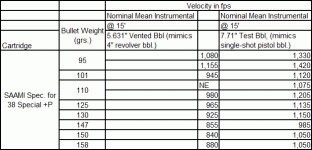Webleymkv said:…For .38 Special, however, CIP's max pressure is 22,000 psi which is greater than even SAAMI's 20,000 psi limit for .38 Spl +P (CIP does not recognize any +P designations).
Note that CIP numbers are measured by a Kistler 6215 or similar piezoelectric transducer screwed into a hole in the pressure test gun that is aligned with a hole drilled into the case at 12.5 mm forward of the head in the pressure gun chamber. The U.S. pressure is measured through a hole in the pressure gun that is coupled to the transducer via a short steel connecting rod that is contoured to match the chamber at 0.600" (15.24 mm) forward of the head. This is done on the theory that pressure outside the case is what the chamber will experience and is, therefore, more important to know than the pressure inside the case as measured by the CIP method. There turn out to be drawbacks and advantages to both approaches, but the bottom line is the methods typically don't get matching results unless the transducers are first cross-calibrated with the other organization's reference ammunition. So, while the CIP method may produce a magnitude of 22,000 psi as the maximum average peak pressure, there is no way to know a load that matches that specification won't read 17,000 or 20,000 psi on SAAMI-style equipment without doing that cross-calibration.

